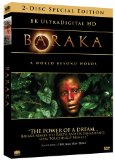| Reviews & Columns |
|
Reviews DVD TV on DVD Blu-ray 4K UHD International DVDs In Theaters Reviews by Studio Video Games Features Collector Series DVDs Easter Egg Database Interviews DVD Talk Radio Feature Articles Columns Anime Talk DVD Savant Horror DVDs The M.O.D. Squad Art House HD Talk Silent DVD
|
DVD Talk Forum |
|
|
| Resources |
|
DVD Price Search Customer Service #'s RCE Info Links |
|
Columns
|
|
|
Baraka: 2-Disc Special Edition
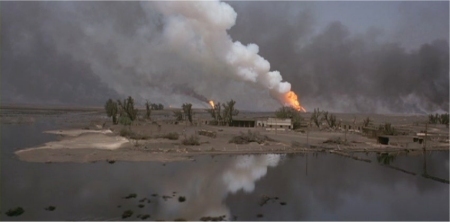
If a picture is worth a thousand words, it's obvious why Ron Fricke's globetrotting Baraka (1992) doesn't bother with narration. Produced entirely in high resolution "Todd-AO" format (filmed on a 65mm negative and printed on 70mm stock), Baraka cuts no corners in the visual department; from start to finish, this celebrated film depicts Earth as seen through truly artistic eyes. Filmed in 24 countries on six continents (sorry, Antarctica) during a fourteen-month period, Baraka's crew was often no larger than five in number. As a result, this visually-driven production feels more intimate and focused than most films much smaller in scale. Fricke, who also served as cinematographer on Godfrey Reggio's landmark Koyaanisqatsi a decade earlier, designed and built the 65mm camera used for Baraka and later projects. As expected, such a hands-on approach paid off in the long run.
Unlike more heavy-handed "global documentaries" (for lack of a better term), Baraka isn't a finger-pointing exposé about how we're destroying the planet; more than anything else, it's a meditation on unbridled nature, animal behavior and human rituals. This relatively wordless film is driven completely by music---in this case, contributions by Brendan Perry, Lisa Gerrard, Andean music group Inkuyo and Michael Stearns, among others---and quickly establishes a more abstract atmosphere in the process. Knowledge of foreign cultures, or lack thereof, may influence one's appreciation of the film; as mentioned earlier, there is no narration (or even on-screen captions) to remind us what we're watching. This can prove frustrating the first time around...but once it's realized that Baraka is more of a loose, spiritually-driven film than a purely educational one, it becomes a much more enjoyable and rewarding experience.
Those familiar with the Quatsi trilogy and Fricke's own Cronos (1985) will appreciate Baraka's heavy use of time-lapse photography and leisurely tracking shots. Bustling cities resemble ant colonies and clouds flow by like white rapids, while slower trips through empty museums and palaces seem almost glacial in comparison. In regards to the time-lapse portions of Baraka, the skeleton crew would often work in 24-hour rotating shifts, often shooting all night for a dozen or so seconds of footage. Battling unpredictable weather, mounting travel costs and sporadic month-long trips into completely foreign cultures, Fricke's dedicated crew occasionally lucked into "happy accidents", from unexpected nearby attractions to unusually cooperative wildlife. Of course, virtually any film---especially those shot outside the comfort of a backlot---will run into its fair share of problems, but the perfectly measured final cut of Baraka hides such problems with ease.
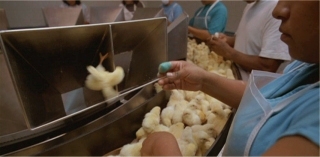
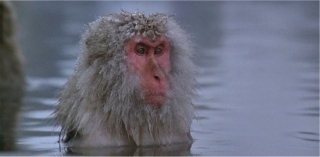
It's obvious even upon first viewing, but Baraka is about as precise and uncompromising as films get---and at this visual level, such an approach is practically necessary. The film's brilliantly-lit night sequences (most of which are time-lapse) were timed to be shot according to lunar phases, ensuring that a full moon would be present for maximum illumination. Location coordinators frequently met with local still photographers, who could provide helpful tips about when and where the natural light was most interesting. In fact, Baraka's precision proves to be the perfect compliment to the loosely connected flow of its story: we're enveloped completely in the world that Fricke and company represent, but we're still allowed to piece together the images on our own terms. Elements like this are what elevate Baraka above the norm, capturing our attention even after multiple viewings. NOTE: Fricke's sequel to the film, entitled Samsara, is currently in production and scheduled for release in 2009.
Originally released in 2001 as a highly compressed WS/FS disc and again in 2001 as an anamorphic Special Edition, Baraka's third trip to DVD (again, courtesy of MPI Home Video) appears to be anything but a cheap cash grab. Featuring an absolutely perfect technical presentation and a pair of engaging new extras, there's enough here to make Baraka worth buying again---and if you're new to the film, this 2-Disc Special Edition is practically a no-brainer. Let's take a closer look, shall we?
Presented in a 2.21:1 aspect ratio (the film's original aspect ratio, according to the packaging) and enhanced for 16x9 displays, Baraka looks absolutely fantastic from start to finish. Naturally, the packaging trumps up the film's technical specs by throwing in terms like "8K Ultra Digital HD"---which should be taken with a grain of salt, considering DVD's resolution limit of 480p---but without a doubt, this looks as perfect as standard definition will allow. Digital problems---including edge enhancement and pixellation, for example---are virtually non-existent, image detail is extremely crisp, the color palette is well saturated and black levels are rock solid. One can only assume the forthcoming Blu-Ray release will be even more impressive; for now, this is easy demo material for those who haven't moved on to high definition. Though I don't have the 2001 Special Edition on hand for a side-by-side comparison, there's no way it could look this perfect.
As expected, Baraka's audio presentation is equally impressive. The music-driven atmosphere comes through loud and clear in your choice of Dolby Digital 5.1 or DTS mixes, but you can't go wrong either way. Baraka's dynamic range is very strong, surround activity is ample and the LFE channel also kicks in on several occasions. In one of the accompanying special features, Baraka's production team describes the film as "one-third cinematography, one-third editing and one-third music"; luckily, there are absolutely no worries about the latter (or the former, if we're keeping score). Due to the nature of this release, the lack of subtitles and Closed Captions isn't surprising...but it's a shame the bonus features don't support either one.
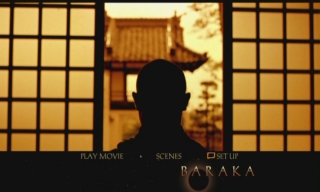
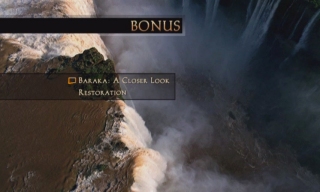
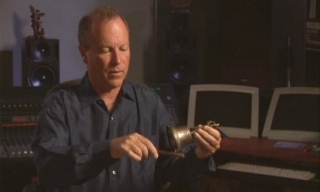
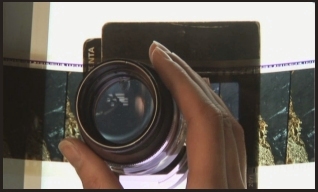
Also here is "Restoration" (7:04, above right), an overview of the cleanup work involved for this new release. Featuring comments by Mark Magidson, project supervisor Andrew Oran, restoration producer Christopher Reyna and large format digital producer Rick Lopez, this short featurette takes us on a whirlwind tour of how Baraka was polished from top to bottom. Among other tidbits, we learn that it took roughly three weeks to digitize Baraka at 8K resolution, which ended up being a 30 terabyte file. A few before-and-after comparisons are provided, but this is more of a talking-head discussion than a purely visual affair.
Both extras are presented in 1.78:1 anamorphic widescreen and include uncropped film and production clips. Unfortunately, no optional subtitles and/or Closed Caption support are included here, which proves to this release's only notable oversight.
As captivating now as it's ever been, Ron Fricke's Baraka remains a compelling look at the world around us. Thankfully, it's not preachy and manages to flow quite smoothly during its 97-minute running time---and even though it's hardly the first narrative-free "global documentary", Baraka remains one of the very best. MPI's new 2-Disc Special Edition pulls out all the stops, even trumping the much-lauded 2001 edition: boasting an immaculate technical presentation and a thorough production documentary, Baraka is a truly well-rounded release that fans will enjoy from top to bottom. Owners of either previous version shouldn't mind making the upgrade, while those new to Baraka are strongly encouraged to consider a blind buy. Very Highly Recommended.
Randy Miller III is an affable office monkey based in Harrisburg, PA. He also does freelance graphic design projects and works in a local gallery. When he's not doing that, he enjoys slacking off, second-guessing himself and writing things in third person.
|
| Popular Reviews |
| Sponsored Links |
|
|
| Sponsored Links |
|
|
| Release List | Reviews | Shop | Newsletter | Forum | DVD Giveaways | Blu-Ray | Advertise |
|
Copyright 2024 DVDTalk.com All Rights Reserved. Legal Info, Privacy Policy, Terms of Use,
Manage Preferences,
Your Privacy Choices | |||||||









